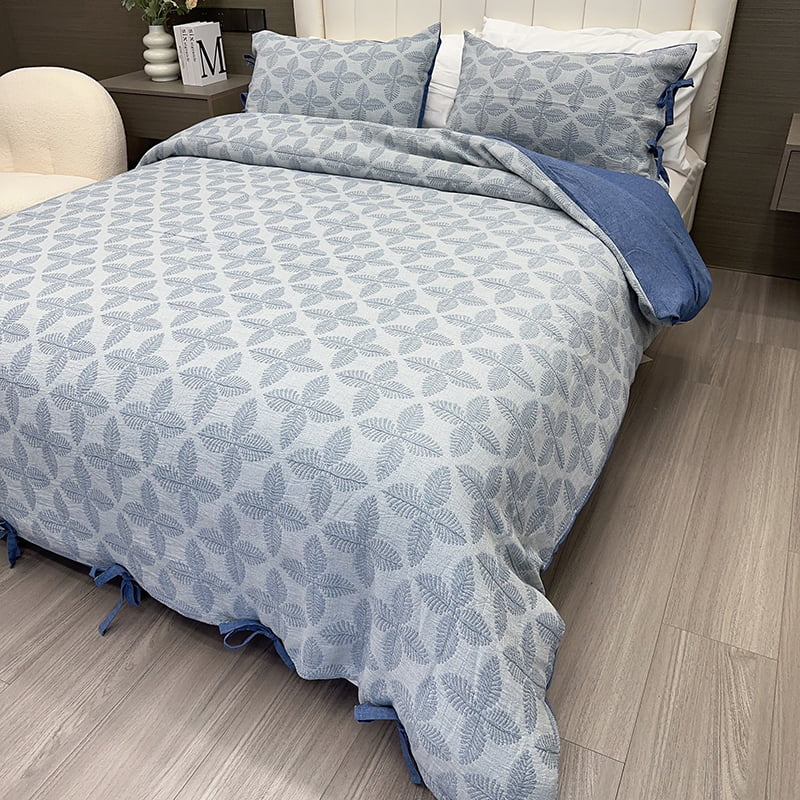When you're shopping for new bedding, especially for something as central as a duvet cover, you'll encounter a variety of terms that describe how the fabric is made. Phrases like Jacquard, embroidered, tufted, and printed all refer to different methods of creating patterns and textures on textiles. While they might all look visually appealing, understanding the fundamental differences between them can help you make a more informed decision about what's right for you. This guide will break down each technique, focusing on the craftsmanship and characteristics that make each one unique.
Jacquard: Woven for Intricate Detail
The Jacquard weaving technique is a marvel of textile engineering. It's named after its inventor, Joseph Marie Jacquard, who developed a loom in 1804 that could automate the weaving of complex, intricate patterns. Unlike other methods where patterns are added to a finished fabric, Jacquard patterns are woven directly into the fabric itself as it's being made.
This process involves a special attachment on the loom that controls each individual warp (vertical) yarn, allowing for an incredible level of detail and complexity. The pattern is not just on the surface; it's an integral part of the fabric's structure. This gives Jacquard fabrics a distinctive, luxurious feel and a durability that other methods can't always match. The pattern often has a subtle, three-dimensional effect, with different parts of the design catching the light in unique ways. This is why a Jacquard Duvet Cover often has a rich, high-end appearance, making it a timeless addition to any bedroom. The pattern is reversible, though the back will appear as an inverse of the front, with the colors flipped. This inherent quality of the weave makes Jacquard fabrics highly sought after for both their beauty and resilience.
Embroidered: Stitched for Sophistication
Embroidered fabrics are created by stitching a design onto an existing piece of fabric. This is a decorative technique where threads are used to create a pattern on a plain background. The process can be done by hand or by machine, with the latter allowing for precision and speed.
The key difference here is the method of application. While Jacquard patterns are built into the fabric from the ground up, embroidery is an embellishment added on top. This creates a raised, tactile texture that stands out from the base fabric. You can literally feel the threads of the design. Embroidery can be incredibly detailed and colorful, often used to create a sophisticated and classic look. However, because the design is applied to the surface, embroidered patterns can be susceptible to snagging or pulling if not handled with care. The quality of the stitching and the density of the thread will determine how durable the embroidery is over time.

Tufted: Piled for Plush Texture
Tufted fabrics are known for their distinctively plush, three-dimensional texture. This technique involves creating loops or cuts of yarn that stand up from the fabric's surface. Think of the fluffy, soft surface of a shag rug or a high-pile blanket; that's tufting in action.
The process typically involves pushing a thread or yarn through a base fabric, forming a loop on the other side. These loops can be left as they are (known as loop pile) or cut to create a velvety surface (cut pile). Tufting is used to create both simple geometric patterns and more intricate, free-form designs. The main purpose of tufting is to add a soft, voluminous texture, making it an excellent choice for items like throws, bath mats, and cozy bedding. Unlike the flat-woven Jacquard or the stitched embroidery, tufting is all about creating a sense of depth and comfort through its raised fibers.
Printed: Applied for Versatile Design
Finally, printed fabrics are the most straightforward and versatile of the four. In this method, a design is applied to the surface of a finished, plain fabric using inks or dyes. This can be done digitally, using screens, or through other printing techniques.
The primary advantage of printing is the near-limitless potential for color and design. You can achieve photorealistic images, intricate repeating patterns, and a vast array of color combinations that would be difficult or impossible to create with weaving or stitching. However, since the pattern is only on the surface, printed fabrics can sometimes feel less luxurious than their woven or embroidered counterparts. The design may fade over time, especially after repeated washing, and the feel of the fabric remains flat. The quality of the print and the type of dye used are crucial factors in determining the longevity and vibrancy of the pattern.
The Takeaway
While all four techniques can produce beautiful fabrics, they do so in fundamentally different ways. Jacquard weaving creates patterns from the ground up, making them part of the fabric's inherent structure. Embroidery adds decorative stitching to a finished fabric, creating a raised, tactile design. Tufting builds a plush, three-dimensional surface. And printing applies a pattern to the surface using inks.
When you're choosing your next bedding set, like a Jacquard Duvet Cover, consider not just the look but also the feel and durability. The craftsmanship behind each method directly influences how the fabric looks, feels, and stands up to the test of time. Choosing a Jacquard piece means investing in a pattern that is woven to last, a true testament to the art of textile creation.



 English
English Español
Español عربى
عربى







 +86-159 5050 0822
+86-159 5050 0822 peter@rainbowhomefashion.com
peter@rainbowhomefashion.com No.199 Yimin Road, Dateng DIstrIct, Yancheng City. Jiangsu Province, China
No.199 Yimin Road, Dateng DIstrIct, Yancheng City. Jiangsu Province, China
